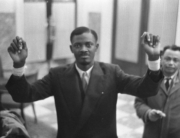
In Five Years North, viewers get an in-depth look into the lives of two individuals standing at polar opposites of the Central American migration crisis. Sixteen-year-old undocumented Luis fled his village in Guatemala to New York City in search of economic opportunity and to send money back home to his family. Judy, a Cuban-Puerto Rican-American ICE officer, is trying to make end’s meat while patrolling the heavily immigrant neighborhood of Queens where Luis resides.
Much of the film is structured around the weeks and days leading up to Luis’s court hearing, where a judge will decide whether he will be deported. In the meantime, he resides with his uncle Mario and cousin Gabriel who’ve been in New York City for years. Directors Chris Temple and Zach Ingrasci trail Luis as he goes to school, deals with social workers, and works part-time as a food-delivery worker and dishwasher—one of his aspirations, besides becoming financially stable, is to work his way up to becoming a chef. His struggles take a dark turn when it is revealed he has to pay back a significant debt to the smugglers who brought him to America, as well as the debt of his father, Pedro, who was deported back to Guatemala.
One of the most compelling scenes involve those of Luis’s family back in Guatemala. Temple and Ingrasci follow the day-to-day lives of Luis’s hard-eyed parents and aging grandmother, all of whom remain in close contact with Luis via smartphone. In one scene, Luis suffers a panic attack, as well as ominous nightmares, and calls his worried mother, who reassures him that everything will eventually be all right. It’s a familiar but nevertheless heart-wrenching scene that highlights the emotional plight of kids compelled to leave their home in search of a better life. The scenes in Guatemala are perhaps the most illuminating, but the filmmakers could’ve devoted more screen time there to contextualize the socio-economic plight that forces many to leave for the North.
Understandably, though, Five Years North keeps the core of its scope microcosmic. Through Judy, Ingrasci and Temple attempt to highlight the larger, systemic contradictions inherent in the U.S response to the migration crisis. Judy’s own feelings about it are mixed, and her constant moral apprehension are stitched onto her face. She understands these contradictions well, having an immigrant mother, and at one point even makes it clear that she knows her agency doesn’t deport only migrants with criminal records.
In one telling sequence, Judy and her squad apprehend a Dominican man in Queens who was charged with distributing cocaine many years ago. He has since turned himself around to make an honest living. The team corners him at a convenience store and handcuffs him, much to the protest of his employer and the bodega clerk watching. Judy makes it clear she wishes she could arrest migrants without having their families see it and that she and her colleagues try to “avoid it when they can.”
Judy’s secure, modest middle-class lifestyle—complete with a generous federal pension—contrasts with the more precarious, destitute living standards of Luis and his family, underlining the costs of the American Dream and how often these costs are hidden beneath the veneer of “duty,” and at the expense of the marginalized.
Five Years North is ultimately a straightforward but nevertheless illuminating documentary about some of the U.S.’s most precarious residents. As climate change worsens, so will the refugee and migrant crisis. As such, stories like Luis and his family serve as powerful reminders of the lives that are at stake, as economic inequity continues to more starkly split the globe between the haves and have-nots.






Leave A Comment